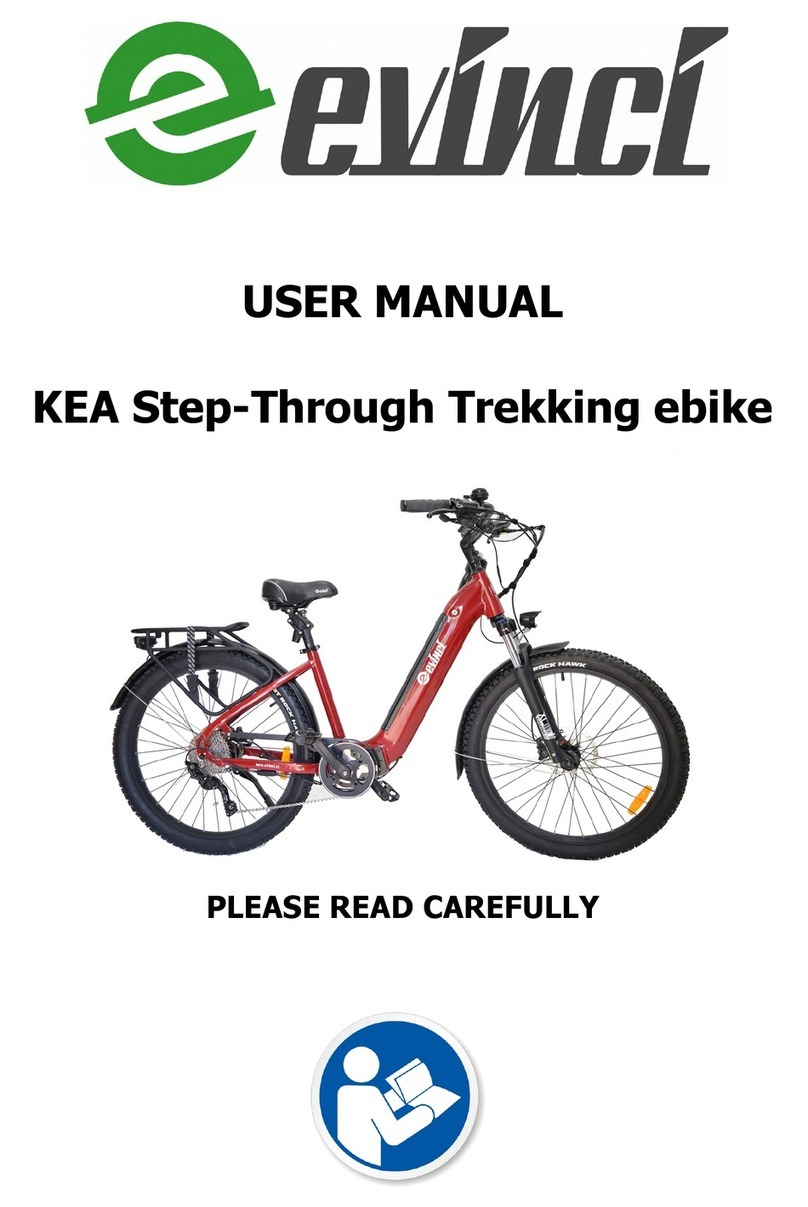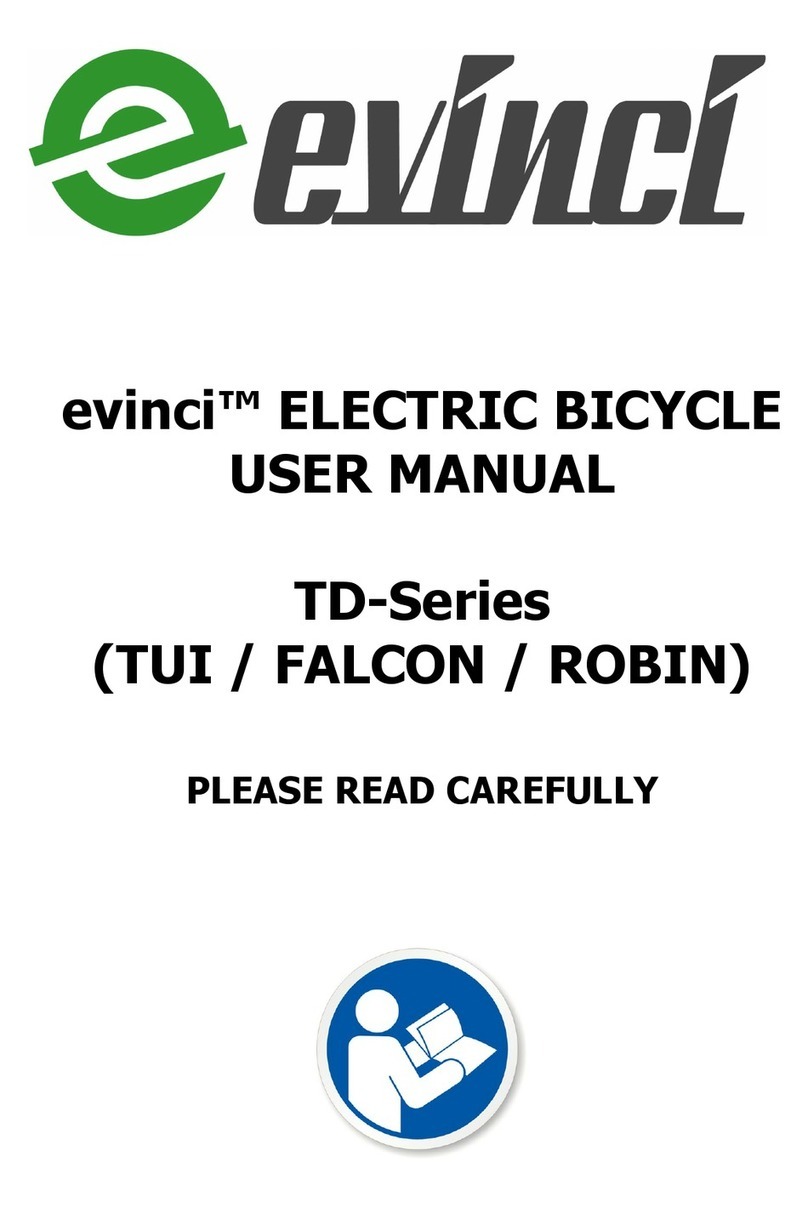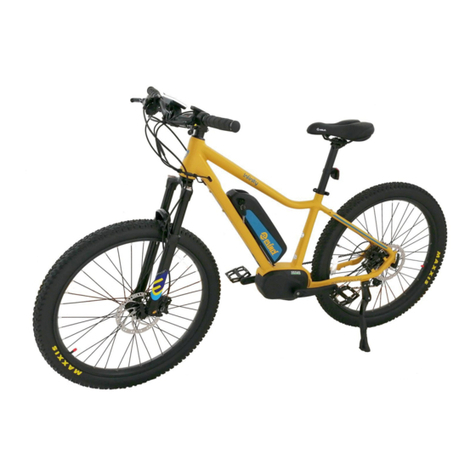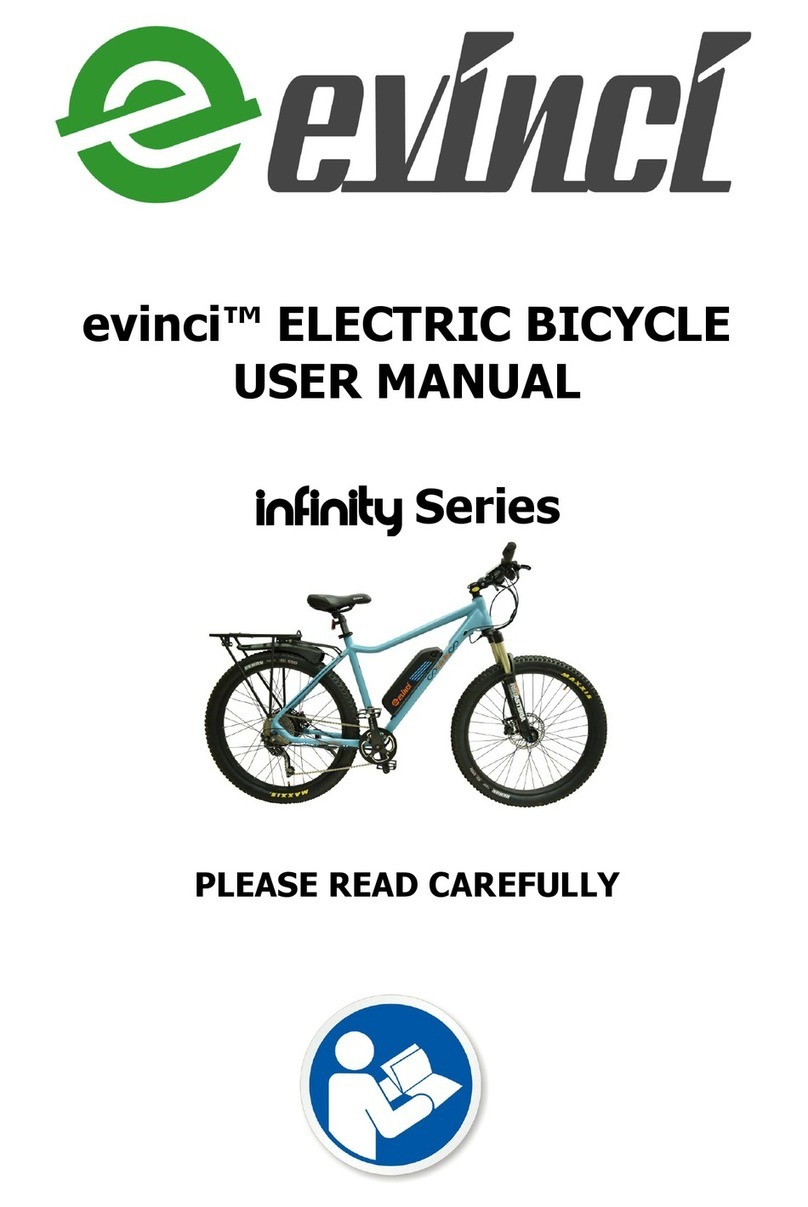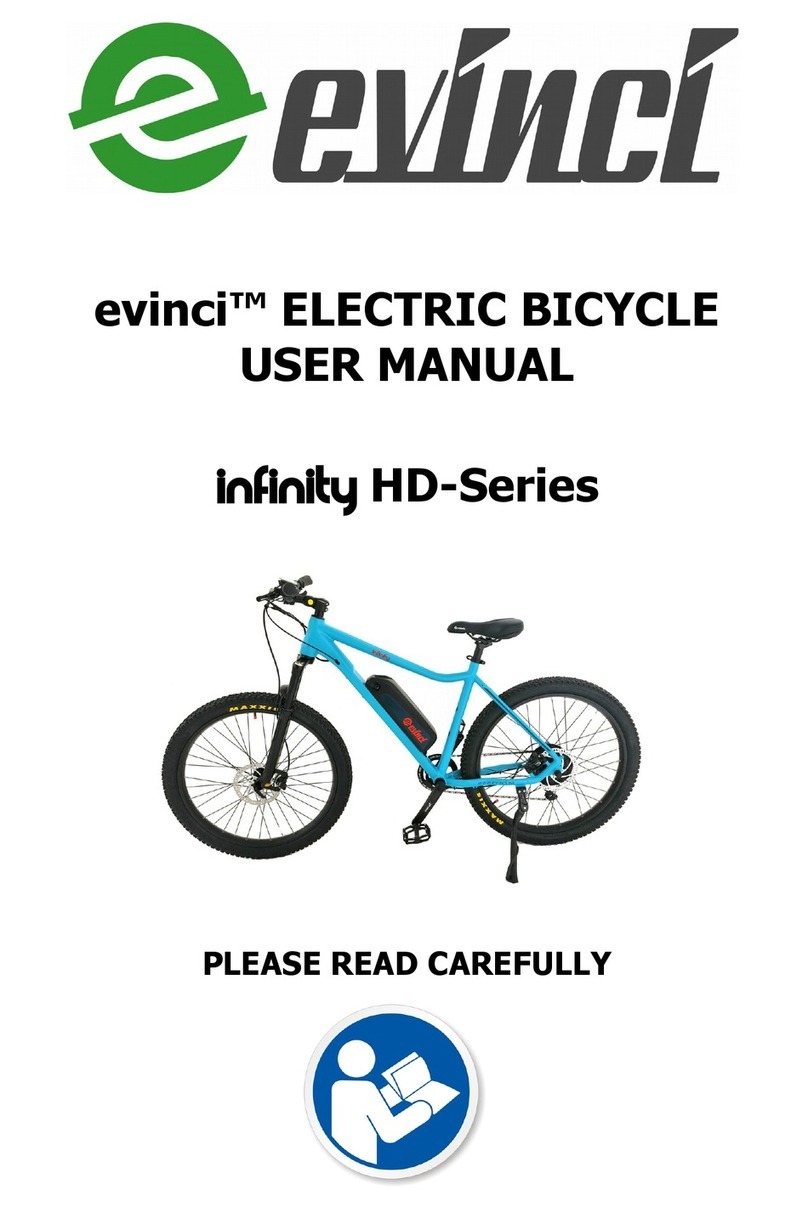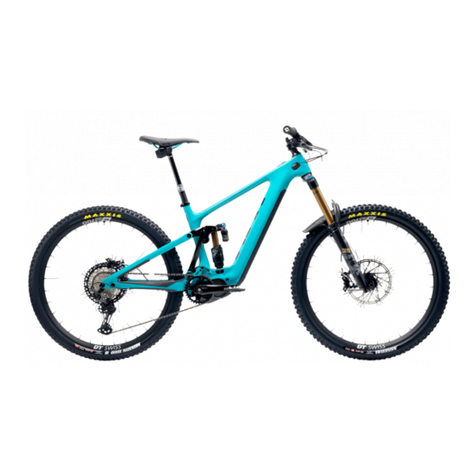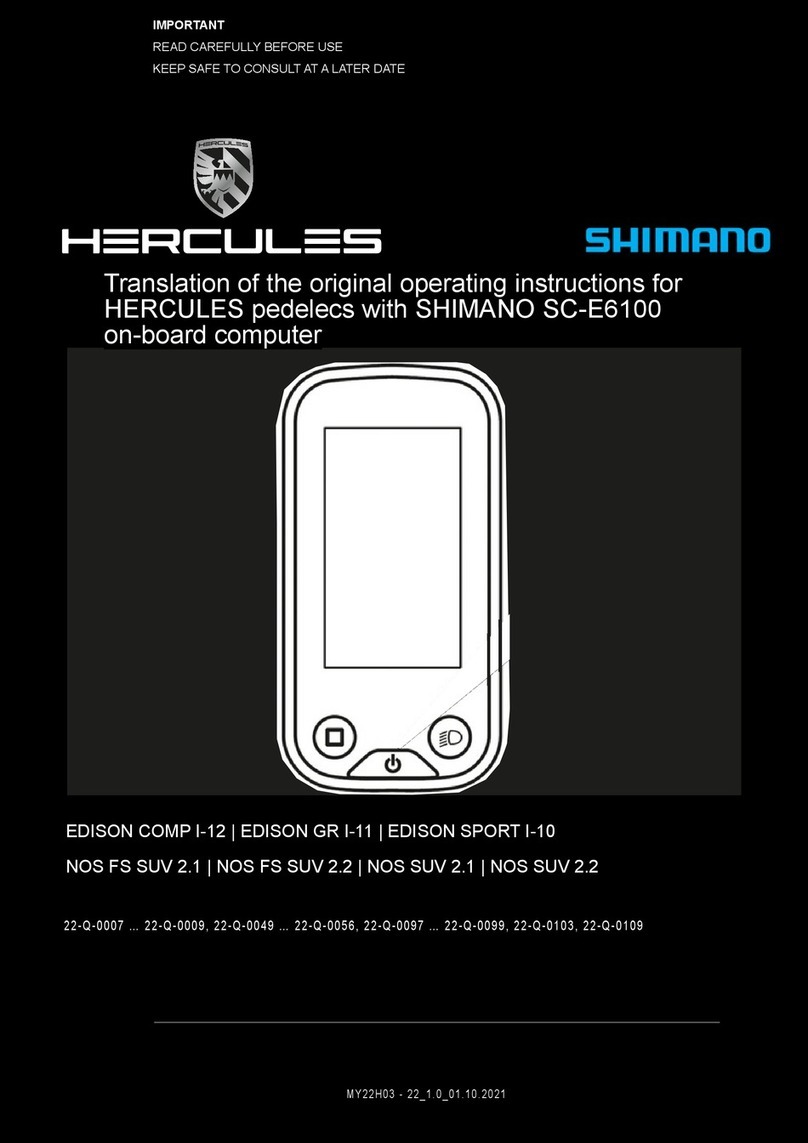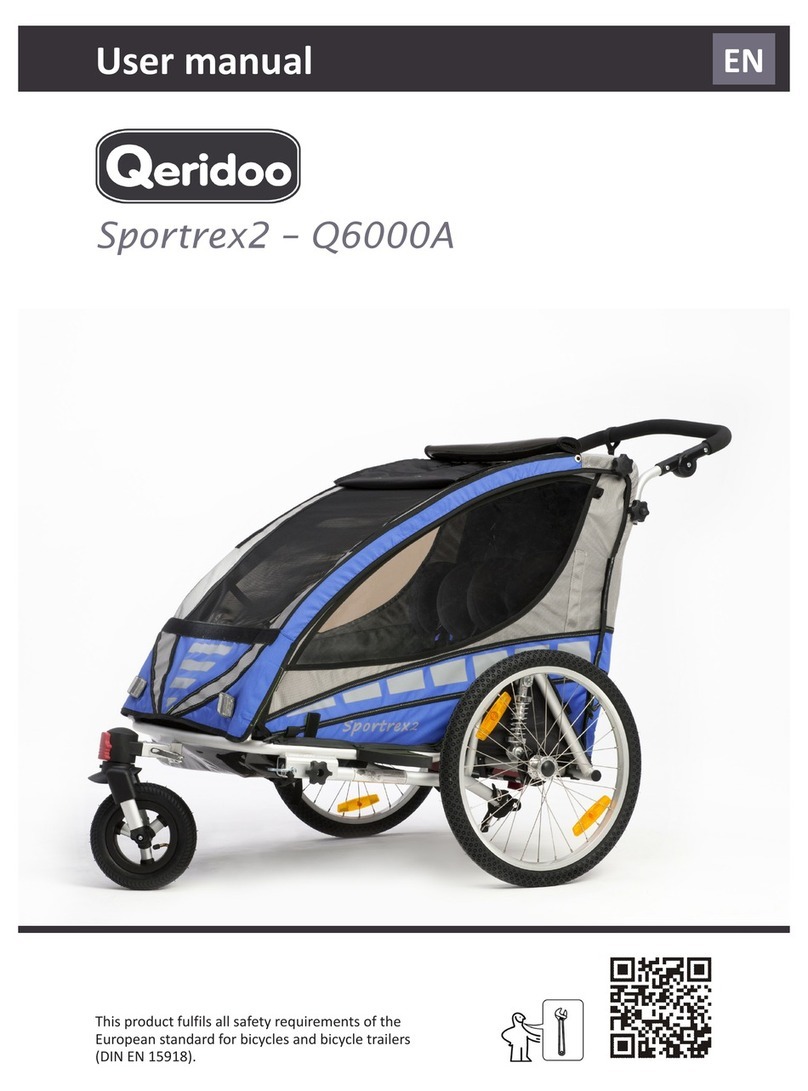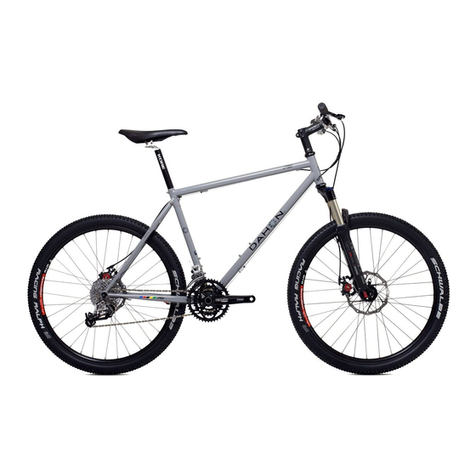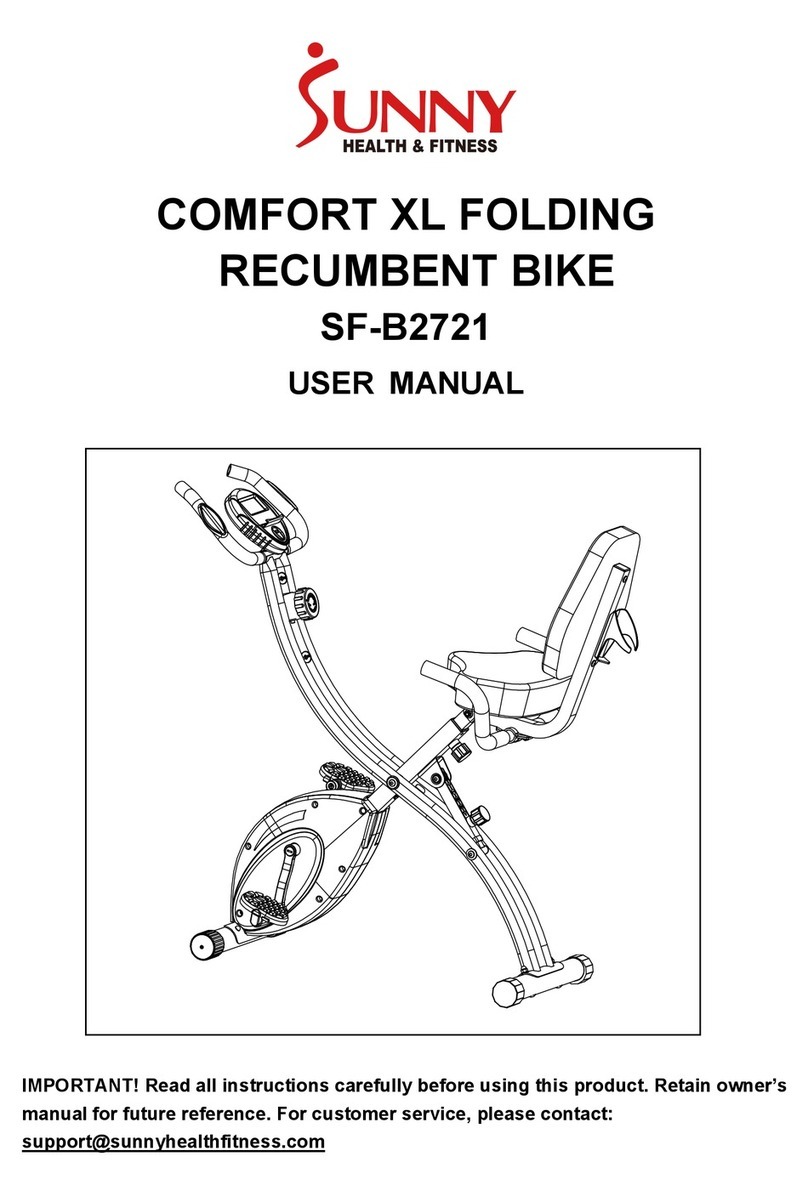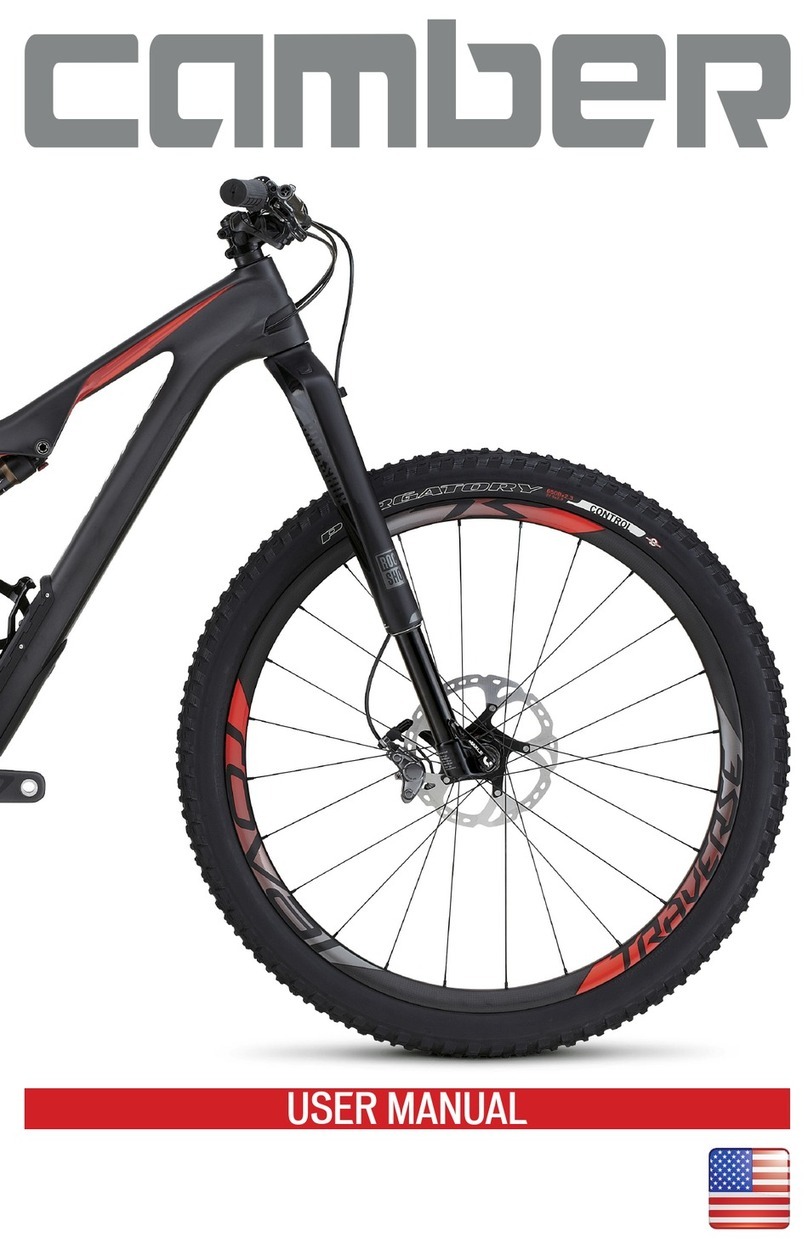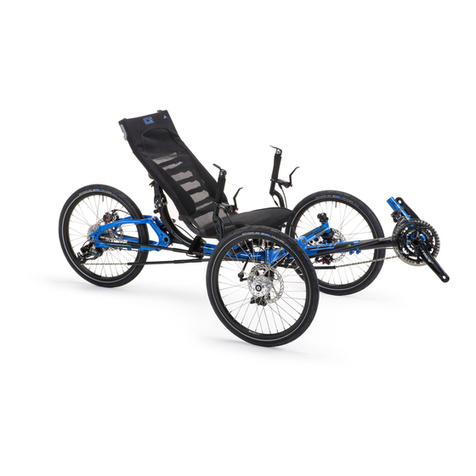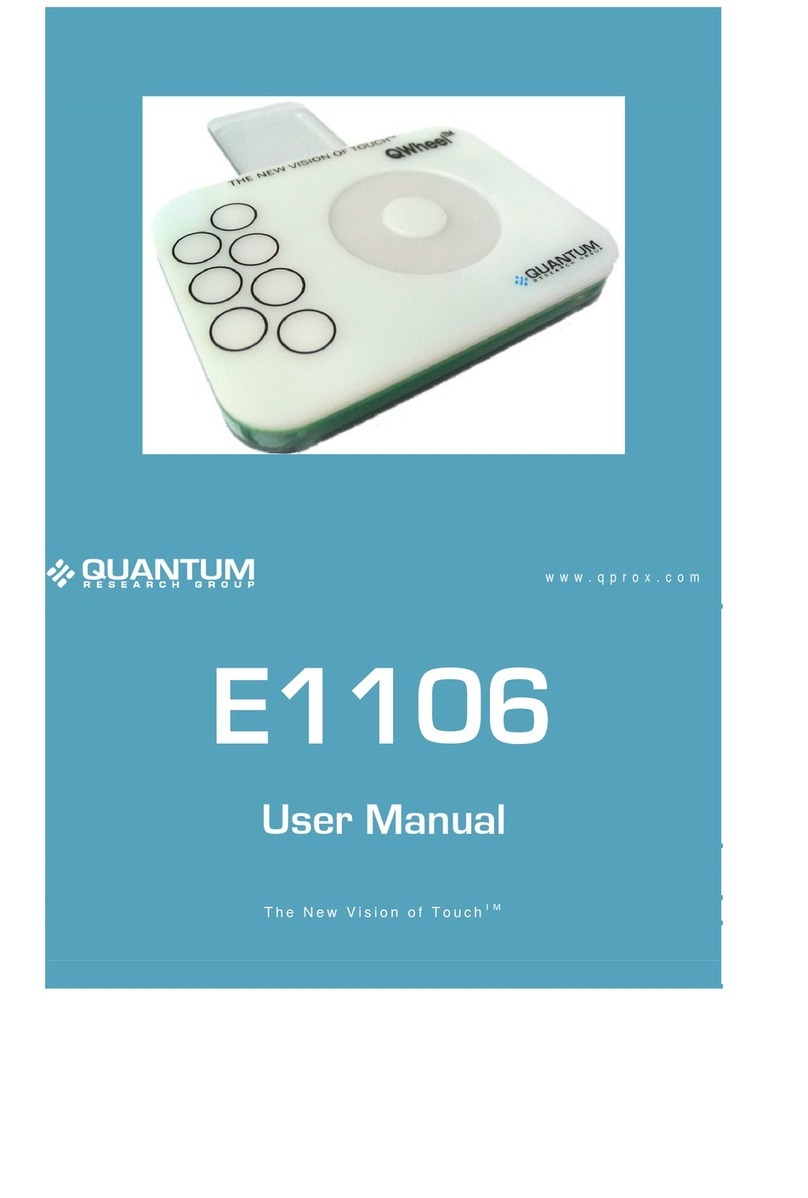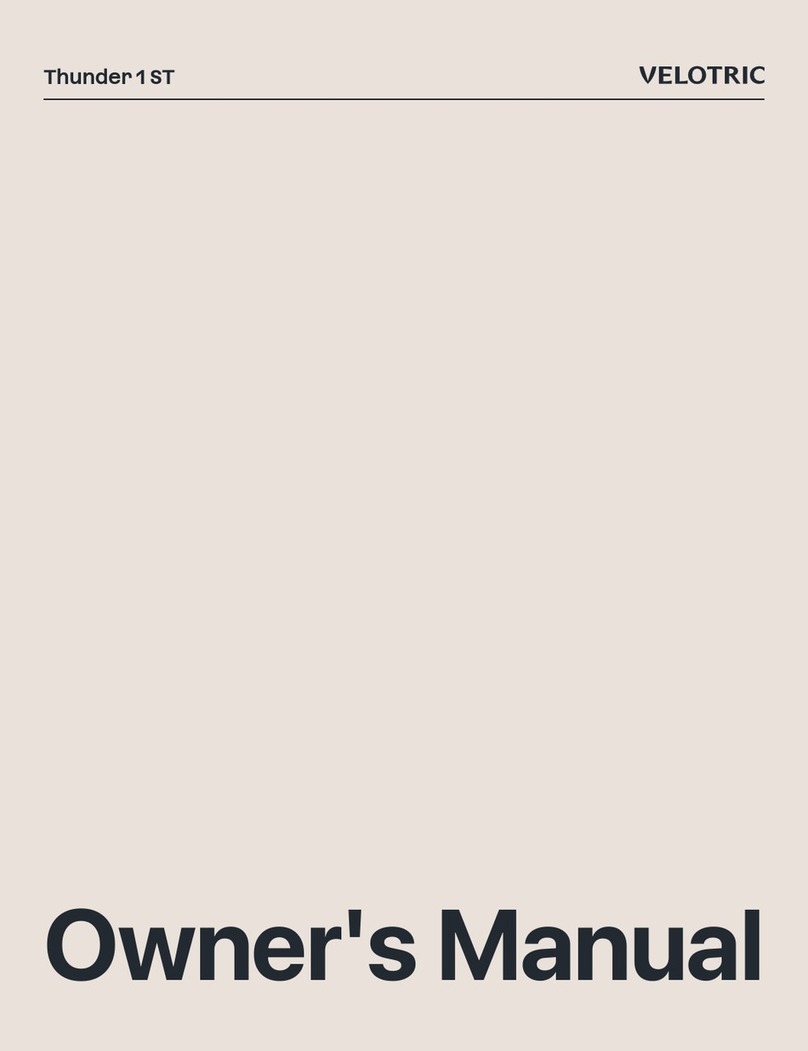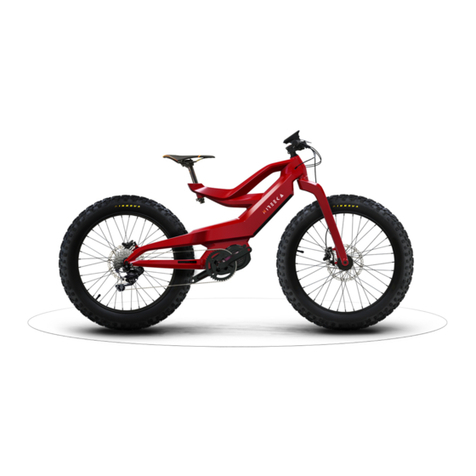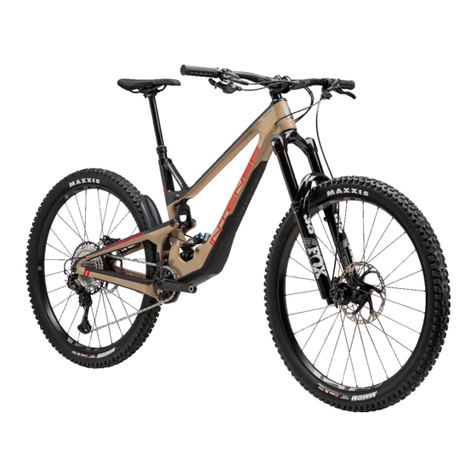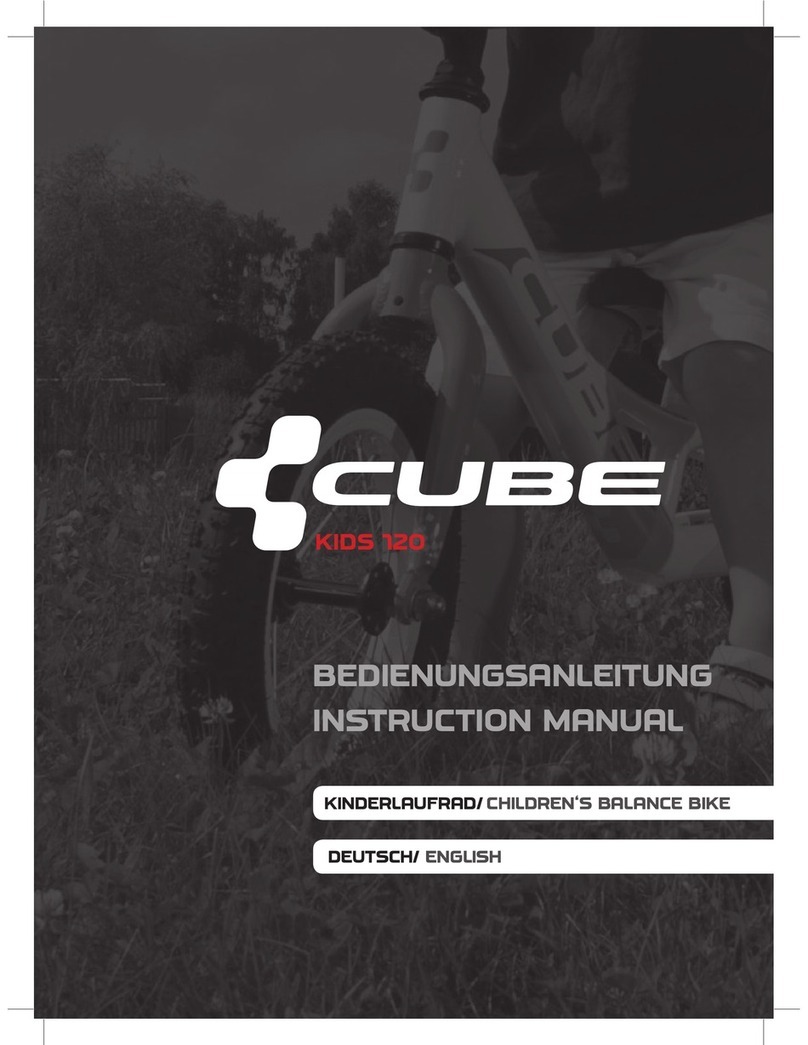Evinci TD Plus-Series User manual

evinci™ ELECTRIC BICYCLE
USER MANUAL
TD Plus-Series
TUI+ / FALCON+
PLEASE READ CAREFULLY

T ble of Contents
Safety Instructions........................................................................................3
Symbols.......................................................................................................3
Introduction.................................................................................................4
Modes of operation and extent of electronic power assistance.........................................4
Levels of support (as shown as Assist number on display ...............................................4
What comes with the bike?............................................................................4
Optional available accessories.......................................................................................5
TUI / FALCON – components.........................................................................5
Basic Safety Tips...........................................................................................6
For your own road safety..............................................................................................6
How to use your charger...............................................................................6
Safety notes concerning the battery...............................................................8
Charging the battery.....................................................................................9
How to remove and insert the battery............................................................................9
Before starting to ride.................................................................................10
Adjust Seat height......................................................................................................10
How to find the correct saddle height?.........................................................................10
Adjusting the saddle angle..........................................................................................10
Mount or dismount front wheel....................................................................................11
Adjust the stem and handlebar....................................................................................11
Check tire pressure.....................................................................................................11
Operation...................................................................................................12
Display functions........................................................................................................12
Throttle......................................................................................................................13
Gears.........................................................................................................................13
Brakes.......................................................................................................................14
Maintenance...............................................................................................14
Brakes.......................................................................................................................14
Gears.........................................................................................................................15
Lubrication.................................................................................................................15
Cleaning your bike......................................................................................................15
Safety points..............................................................................................................15
Repairing a puncture...................................................................................................16
Removal of rear wheel................................................................................................16
Trouble shooting.........................................................................................17
Glossary.....................................................................................................18
BMS...........................................................................................................................18
Controller...................................................................................................................18
Display.......................................................................................................................18
Hall sensor.................................................................................................................18
Pedal Assist Sensor (PAS ............................................................................................18
Torque Sensor............................................................................................................19
2

Safety Instructions
Thank you for purchasing an
evinci
electric bike, designed by NZEBIKES. This
electric bicycle features the most recent innovation in technology and applies to
the AS/NZ standard. For safety reasons, it is most important that you read this
User Guide BEFORE you operate the bike. Improper handling can reduce its
riding performance and most importantly, pose danger to your safety and
health!
NZEBIKES is continuously updating and innovating this product. The printed
manual may therefore not always include the latest updates. However, we shall
make sure that our online manual will always be up to date on
www.evinci.nz/support.
We want also encourage you to register your bike with your
frame serial number. This allows us to help you finding your
bike in case of theft, as we get contacted by the police when
bikes are recovered.
Your frame serial number is stamped into the front of the
headset tube below the handlebar.
To register just go to our
evinci
website (evinci.nz and click on “Login” to
create an account with your details. You may register up to two bikes within
the same account.
Symbols
Please pay particular attention to information next to one of the symbols shown
below as it can be very important for your personal safety.
WARNING
This symbol indicates that improper handling poses a
risk to your health and safety
ATTENTION
This indicates that improper handling could damage
components and make
void the warranty.
NOTE
Points out to useful tips
3

Introduction
You have decided in favour of a Pedelec (Pedal Electric Cycle - a bicycle that is
equipped with an electric motor to give you additional assistance when riding.
With this bicycle you can make better progress in headwinds, when trans-
porting heavy loads or on steep slopes.
You can select the level of power assistance required according to the weight of
your load and/or the prevailing road conditions, the effectiveness of the power
assistance depends on your pedal power and the level of assistance selected.
Before switching on the electric assistance system, please read the chapter
“Charging the battery”. The battery must be fully charged before you go for a
ride the first time.
Modes of operation and extent of electronic power assistance
As soon as you turn on the electric assistance system and begin pedalling or
turning the throttle, electronic power assistance is available. Depending on the
selected assistance level and mode the motor will add a certain amount of
power to assist you.
There are two riding modes in this ebike model:
Pedal Assist
and
Torque Assist
.
With
Pedal Assist
the more you pedal on your own the less power the motor
has to add, which increases the all over range.
Pedal Assist
does not measure
your pedal effort, this means you can relax when being exhausted and let the
motor take over most of the work. Just keep in mind that the battery will get
used up faster.
Torque Assist
will add a certain amount of power depending on the selected
level and how much you push into the pedals. This creates are more natural
riding experience and gives you more control. It will also increase the average
range you can achieve.
Levels of support (as shown as Assist number on display)
There are three Torque Assist levels:
1 = ECO, 2 = STD, 3= PWR
And five Ped l Assist support levels:
4 = 20%, 5 = 40%, 6 = 60%, 7 = 80%, 8 = 100%
With higher support the motor will reach also a higher speed.
What comes with the bike?
•240V mains charger
•A set of 2 keys for the battery lock
•Integrated LED lights, front and rear
4

•Mudguards
•Carrier, rated 25kg
ptional available accessories
•High power CREE LED lights, rechargeable
•Front and rear baskets
•Motor home battery charger
Please ask your dealer if you are interested in any of these items.
TUI / FALC N – components
1 LCD Control Display 5 Battery Lock
2 Gear Shifter 6 Hub Motor
3 Throttle 7 Derailleur
4 Adjustable Stem 8 Torque Sensor
5

Basic Safety Tips
Always pull the brakes and hold the handlebar firm and
straight before taking off in order to make sure you keep
control of the bike when power assistance is in action! NOTE
that power assistance is triggered off IMMEDIATELY as soon
as the crank moves slightly in riding direction. Also, keep in
mind that the right hand half-throttle is active. By pulling one
of the brakes the motor will be disengaged.
For your own road safety
●Always wear a suitable bike helmet
●Wear bright clothing or reflective elements to
be seen better by other road users
●Wear shoes with a non-slip sole
●Wear close-fitting clothing on your legs or
wear trouser clips
●Wear bicycle gloves
●Use your bike lights also during day light as
they make you better stand out
How to use your charger
To charge the battery your
evinci
bike comes with a 3Ah quick charger. Please
do not use any other charger.
If you want to charge your battery from a car or motor home
(12V systems , NZEBIKES or your retailer can supply a special
charger called PowerBuddy for this purpose.
Before you first use the charger please read the following notes regarding
safety carefully!
6
Ref (1)

•Keep the charger away from children!
•In order to prevent any possible injury this charger
should only be used for the original lithium battery
which is supplied together with the
evinci
e-bike
•Any other battery is not compatible and risks to explode
while charging, causing serious injury to people as well
as damage to other equipment
•Please make sure that the charger is always kept dry
and does not get wet at any time.
•Place the charger at a well ventilated place as it will get
hot during charging
•Should there be an incidence of contact with water or any other liquid,
make sure to unplug the charger immediately from the power socket and
have it inspected by your dealer.
•Make sure the charger is always placed on a flat surface when in use.
•Please make sure that the charger is always unplugged and removed
from the power socket when not in use.
•Before using the charger, always make sure that the plug and the cables
are not damaged.
•Never connect a damaged cable or plug to the power socket. Never try to
disassemble the charger. There are no serviceable parts in the charger.
•Always unplug the charger before cleaning it. The charger should only be
cleaned with a dry cloth. Never use a wet cloth, oil or any other liquid.
•Only use the original cable supplied with the charger.
7

The charger LED (1 indicates the battery status:
LED STATUS
green the battery is not connected
red the battery is charging
green the battery is charged, the charger has switched off
Before using your battery the first time, it has to be charged
once over night for at least 12 hours.
Safety notes concerning the battery
•Keep the battery out of reach for children
•Never try to open the battery. Apart from this being
dangerous, all warranty will be void
•Do not provoke a shortcut circuit with metal gadgets
•Remove the battery from the bike when transporting on
an external bike rack
•Do not dip the battery in water or any other liquid
•Do not keep the battery close to heat or open fire
•A battery needs to be re-cycled after use, never throw it
in an open fire as it could explode
•If the battery is damaged because it has been dropped
somewhere or because of a biking accident, there might
be a risk of an internal short-circuit
•Immediately stop using a damaged battery.
In order to maximise the use of this battery, please consider the following:
The battery will not charge when exposed to temperatures below +0°C or
above +60°C. It is therefore recommended to keep the battery at room
temperature before charging it.
The charger operates with a microcomputer system with automated control
functions. It automatically stops charging when the battery is full. It cannot be
damaged by overcharging.
None the less, we strongly recommend to always disconnect the power plug
from the wall socket after the battery is charged as power surges, i.e. lightning,
through the grid can damage the charger or battery electronics!
When storing the battery for a longer time period, (>3 months, e.g. over
winter it is important to place it in a dry and cool place. Furthermore it is from
advantage to have the battery only at about 80% charge. There is usually no
need to recharge the battery.
8

Li-Ion batteries have the chemical property to create small
amounts of gas if stored for a longer time period with 100%
charge. This will affect the capacity and life time. From a
technical point of view it is therefore better to store Li-Ion
batteries not fully charged.
Charging the battery
You may charge the battery on the bike or remove it to a
more convenient place. Li-Ion battery have no memory effect,
this means you can top them up as you go
1. Open the rubber cover and connect the charger plug to the battery
2. Connect the power cord to a mains socket
3. Make sure to neatly close the charge port with the rubber cover to
prevent water and dust from getting in
The charger will get warm while charging – do not cover while
in use as it might cause a malfunction.
How to remove and insert the battery
1. Removal: if the battery is locked, first unlock the battery
2. Swivel the seat to the front and pull the battery upwards till it unlocks
from the rail. Move it away from the rail and pull it upwards out
3. Insert: Slide the battery into the battery rail, make sure it sits in it's
correct position (keep it away from the rail till reaching the lowest point .
Secure it in the frame with the battery frame lock
Make sure the battery is fully inserted into the battery rail and
locked to prevent theft.
Never try to push the key into the charge port! It will damage
the key and destroy the charge port
9

Before starting to ride
Adjust Seat height
Open the quick release lever at the seat clamp, adjust seat height and close the
lever firmly. If the lever is too loose, open the lever again and turn the
adjusting nut clockwise till you feel resistance. Now close lever again. It should
close with noticeable resistance.
Never tighten the seat post if the maximum mark is visible,
otherwise you can injure yourself or damage the seat post.
How to find the correct saddle height?
1. Sit on bike saddle
2. Try to reach pedal with your heel when it is in
the bottom position. Your knee should be more
or less fully straightened out
3. Place the ball of your foot on the centre of the
pedal. If your knee is now slightly bend, the
saddle height is correct
Adjusting the saddle angle
Best riding comfort is found when the saddle is horizontal, some riders prefer a
slight forward angled seat.
Never angle a seat backwards as it
can quickly lead to back pain or
physical injuries
1. Loosen the clamping nut on one side anti-
clockwise
2. Tilt the saddle to the required angle
3. Tighten the clamping nut clockwise. Make sure
that the nut it tightened firmly (20 NM
10

Mount or dismount front wheel
For easy transport, you may remove the front
wheel using the quick release at the front wheel
axle (Only Tui and Falcon .
To remove the wheel flip the lever into the open
position. Now hold the lever and turn the bolt
on the other side about 8-9 times to loosen the
axle – do not remove the bolt! You should be now able to lift the wheel out of
the fork.
To mount the wheel repeat procedure the other way round. Guide the rotor in
between the brake pads. Hold the lever pointing parallel to the fork in the open
position (downwards , turn the bolt till you feel a slight resistance. Try to close
the lever – if it is too hard to do so, loosen the bolt a bit and try again.
Before every ride make sure the quick release is tightened
properly. To fail so can lead to serious injuries!
Adjust the stem and handlebar
The models TUI+ and FALCON+ allow an
easy and tool free adjustment of the
handlebar in regard of angle and reach.
Push lock lever in direction of arrow and lift
clamp arm. Adjust height and angle to your
requirements. Push clamp arm back into
lock position.
The clamp pressure can be adjusted with an
Allen key.
Make sure to lock the
clamp arm properly
Check tire pressure
It is very important to maintain the correct tire pressure. Too low pressure will
decrease the range and can lead to rim or tire damages when riding over
edges. The recommended tire pressure is 40 psi.
11

peration
•Turn the display on by pushing
the (M button
•Select the desired assistance
level with the (+ and (– keys.
The initial assistance level is 1
(Torque ECO mode .
•Levels 4 to 8 are Pedal-Assist
levels
•Use the throttle as desired to add additional power to the selected
assistance
•When finished riding keep the (M button pressed for 2 sec to turn the
electrics off
Display functions
B ttery level: The display shows the battery level with 5 bars. Each level is
about 20% of power, when the battery reaches about 10% no bars will be
shown and the battery icon starts to flash. At this stage the controller or
battery might turn off when a higher load is applied, i.e. riding uphill. Please
recharge as soon as possible.
Power: the power bars above the battery indicator shows the rider how much
power the motor uses while riding. More bars means the battery will get faster
depleted.
Turning off: The display turns off automatically after 5 min. To manually turn
it off keep the (M button pushed for 2 seconds.
Trip inform tion: the display shows the current speed and trip details. By
default the last travelled distance will be shown. By pushing the (M button the
following information can be displayed:
Max speed for last trip ODO meter
Travel time last trip Auto cycle (in auto cycle these
information will be shown in a cycle
Last travelled distance automatically .
To reset the trip inform tion: press and hold (+ and (- buttons for 2 sec,
then push (- once to clear trip distance (all other values will be cleared as
well . ODO meter can not be reset! To exit press (+ and (- again. Make sure
that you don't change any other settings.
12

Integr ted LED Lights: To turn the lights on or off push the (+ plus key for
2 sec to toggle the light function. The display is also backlit.
W lk ssist nce: you can activate the motor to
support you pushing the bike up a hill. Press and keep
depressed the (- minus button. After 2 seconds the
motor will start with a maximum speed of 6kph (PAS
level must be >0 .
USB Ch rge Port: to charge your phone you may
open at the back of the display the USB charge port by
removing the rubber plug. Make sure to close the port
neatly after use to prevent any water damage.
Throttle
The right hand side half-throttle allows the rider to add power to the selected
assistance level. This can be useful when starting off or to give you an extra
boost when riding up a hill.
Throttle-only mode: when selecting PAS level 0 no motor
assistance will be provided when pedalling, but the throttle is
still available
Gears
Only change gears while pedalling otherwise the derailleur
might get damaged
If you have to change gears, i.e. to
start off in first gear, lift the rear
wheel using the side stand and turn
the crank while changing gears.
As a rule of thumb, gears on a bike
are changed and used similar to a car
with a manual gearbox.
You will start off in 1st or 2nd gear, on a
flat road you will choose gear 4 or 5 to
pedal along. Uphill go back to 3 or for steeper hills gear 1. If you ride faster or
downhill choose higher gears.
The assistance level chosen on the display will assist you up to a certain speed.
Choose assistance level and gear according to your needs and riding style.
Watch you crank revelations, if you have the feeling you have to push too hard
13

at too low revelations, change to a lower gear. If you pedal very fast with less
effort, choose a high gear or reduce the assistance level.
When you intend to stop it is good practise to change the
gears back to the 1st gear so you may start off without any
problems. This can easily be done while braking and slowly
pedalling as the motor will not push you further.
Brakes
We recommend always to use both brakes at the same time – this allows the
rider to take best control over the braking process without stressing the front or
rear brake. To brake efficiently, your front brake is there to stop you and the
back brake is there to shave off speed. Roughly 70-80% of your stopping
power comes from the front brake. Leaving 20-30% for the back brake.
As soon as one of the brakes gets engaged the motor support will stop.
When using Pedal Assist Mode: to go around narrow corners
by just using the riders pedalling power pull one of the brake
levers only slightly without actually engaging the brake. This
will stop motor support.
Maintenance
Your
evinci
E-Bike needs regular maintenance as any other normal push bike.
All bike shops can help you with these maintenance steps.
There is no maintenance necessary on the electrical components.
Brakes
This bike uses hydraulic brakes which are self-
adjusting. If you feel that the brake force gets
lower or the way you have to press the brake
levers exceed 50% of X (Fig 1 most likely the
brake pads have to be replaced. Please see your
local bike shop.
For further adjustments and maintenance please
refer to the Tektro Maintenance Manual.
14
Fig 1

Gears
Our bikes use a solid and easy to maintain
Shimano Altus gear system.
It can happen after a while that gears do
not perfectly change any more or you
experience a rattling noise while pedalling.
This is normal due to the nature of the
used control wire hulls which get
compressed over time. To re-adjust it is
usually enough to slightly tighten the gear
wire.
For the rear derailleur turn (A anti-clockwise while turning the pedals till the
rattle goes away.
Check if all gears can be reached and changed without problems.
Lubrication
Use very sparsely a special bike lubrication oil on the derailleur and chain. We
recommend to use a wax in water based solution over oil based products as
they do not accumulate dirt, i.e. Squirt Dry Lube
Do not use sprays like CRC or WD40 – these sprays are to loosen
and actually degrease parts, they will do more harm than good.
Cleaning your bike
Just use a dry cloth or if very dirty, a hose and a brush to rinse down. You may
use a soft detergent (i.e. handwash soap to remove greasy residuals. You can
get special bike cleaning products from your local bike shop.
Do not use a water blaster! High pressurized water may enter axle
or crank bearings and damage them! This will void the warranty.
Safety points
We recommend a 6 month interval service or every 1000 km.
Important checkpoints are:
15

▪front axle nuts
▪headset
▪stem clamp
▪bottom bracket and crank
screws
▪rear wheel axles nuts
▪seat post clamp
▪brake caliper screws
▪spoke tension
Spoke tension has to be checked on a regular interval. Failing
can cause spoke breakage and will void the warranty
Repairing a puncture
With the motor in the rear wheel it is slightly more complex to replace a tire or
tube. In case of a puncture we first recommended to check if the puncture can
be repaired using a patch, without removing the wheel from the frame.
1. Lay bike on the derailleur side (protected, or use a repair stand
2. Pull tire off rim (one side is enough
3. Pull tube out of the tire
4. Identify puncture in tube and check tire for any sharp objects to be
removed
5. If tube is still repairable apply patch
6. Refit and pump up tire
Removal of rear wheel
•Change to gear 7 (makes it easier to get chain from cassette
•Unclip motor cable from chain stay
•Unplug motor cable
•Remove axle nuts (take derailleur protector off
•Pull wheel out of drop-outs
Assemble in the same way – make sure to plug in motor cable correctly (arrows
must match . Never force it as it can damage the pins!
16

Trouble shooting
Problem Resolution
Display is turned on, but motor
won't start (throttle or pedal-
assist
Check brake levers – if one of the brake levers
is not in it's initial position the motor won't
work.
Check motor plug at rear stay. Unplug once
and plug back in (Allign arrows! Needs some
force!
Take bike to your retailer for further checks.
Battery is charged and properly
fitted but display won't turn on
If possible measure voltage at the battery
connector (left and right pin . If no voltage
can be measured, take battery to your
retailer.
Check display cable plug if accidentally
unplugged (close to display at handlebar
Charger is plugged in, but LED
stays green
Battery or charger fault, please take battery
and charger to your retailer for further tests
Error code on display Please refer to error code table:
17

Glossary
BMS
BMS is an electronic circuit for battery monitoring. It increases a battery pack's
safety by making sure that all cells are operated within the permitted voltage
range only. When current is too high, temperature is too high or one line of
batteries inside the battery is outside the permitted voltage range the charge
output will be switched off. This avoids total discharge of the battery during
normal operation. An integrated balancer insures that any differences in voltage
between single cells are equalised. In case of a problem with the charging
device the BMS makes sure that the battery cannot be overcharged. A capacity
gauge maybe included to display the remaining capacity.
Controller
The controller is the heart of any electric bicycle. It has the power electronics
to drive the motor and a microprocessor. The controller processes all input
signals coming from the different sensors and it talks to the display on the
handlebar. The microprocessor runs the firmware, which is the piece of
software telling the controller what to do. Firmware updates can be applied to
improve or add functions.
Display
The display is usually mounted to the handlebar and allows the rider to readout
vital information about the e-bike system and control the functions in the
controller. There are different kind of controllers with LED or LCD interface.
Hall sensor
Hall sensors are used in motors, cadence sensors, brake switches and power
throttles. Inside the motor they determine the motor direction and submit it to
the controller so the motor will turn in the right direction right at the start.
Inside the PAS they detect if the magnet disc is rotating. Inside the power
throttle they measure how far the throttle is rotated. Hall sensor can be of the
analogue or digital kind. Functional principal: When hall sensor are passing by a
magnetic field they emit an initial voltage, which is proportional to the product
of magnetic field strength and current (Hall Effect . They are named after their
inventor Edwin Hall.
Pedal Assist Sensor (PAS)
In an electric bicycle the PAS measures if the crank is moving in riding
direction. This information will be passed on the controller which then activates
the motor to support the rider. The PAS can distinguish between forwards and
18

backwards movements of the crank. PAS does not consider how much effort
the rider puts into riding.
Torque Sensor
By measuring the amount of force the rider applies to the pedals the torque
sensor signals without any delay to the controller how much support the motor
has to add. This creates are very responsive but at the same time smooth
riding experience. Torque sensors are mostly placed in the crank, with or
without the motor. They are more expensive to build than PAS sensors.
References
Ref (1 : Ministry of Health NZ, Website
19

20
NZEBIKES 2016 Ltd
19 Esk Street
Tauranga
www.evinci.nz
Ph: 022 675 2699
evinci™ is a registered trademark of NZEBIKES
Rev 3/20 (V1.0
This manual suits for next models
2
Table of contents
Other Evinci Bicycle manuals
